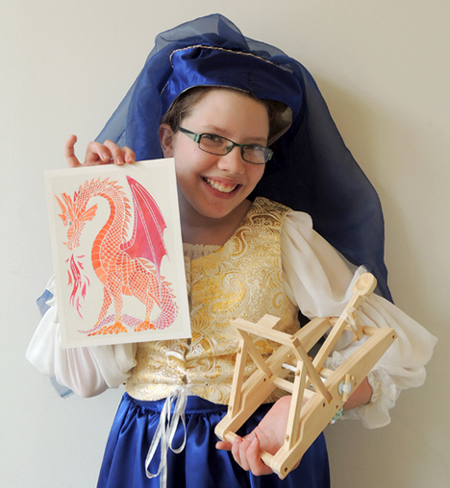 Enter the realm of mythical beasts, sieige engines, and truly stunning Medieval headdresses…it’s time for more kid-tested product reviews! Today, Hope is taking on the Aquarellum Junior paint kit by SentoSphere (ages 7+, retails for approximately $20) and the Tabletop Catapult kit by Sterling Innovation (ages 8+, retails for approximately $25). Have at thee Hope!
Enter the realm of mythical beasts, sieige engines, and truly stunning Medieval headdresses…it’s time for more kid-tested product reviews! Today, Hope is taking on the Aquarellum Junior paint kit by SentoSphere (ages 7+, retails for approximately $20) and the Tabletop Catapult kit by Sterling Innovation (ages 8+, retails for approximately $25). Have at thee Hope!
Hi everyone! I’m back… and this time, with a Medieval twist! First, I’m going to review the Aquarellum kit.
 Opening the box, I found four pieces of light, thin, cardboardy canvas, referred to in the instructions as “Aquarellum Board.” The face of each board had a rendering of a dragon outlined faintly on the surface. One of them looked like a Chinese dragon, and the other three were a jumble of Viking and Medieval. There was also a plastic paint palette, six watercolor paints in bottles, a paintbrush, a plastic eyedropper, and a set of instructions. Dr. Dana thought the instructions were beautiful, and their bright colors captured my attention too.
Opening the box, I found four pieces of light, thin, cardboardy canvas, referred to in the instructions as “Aquarellum Board.” The face of each board had a rendering of a dragon outlined faintly on the surface. One of them looked like a Chinese dragon, and the other three were a jumble of Viking and Medieval. There was also a plastic paint palette, six watercolor paints in bottles, a paintbrush, a plastic eyedropper, and a set of instructions. Dr. Dana thought the instructions were beautiful, and their bright colors captured my attention too.
 The instructions were a 3 page, double-sided foldout. I started reading them hoping to glean a bit of information on using the product. But the instructions were written completely in French! Scouring them, I finally found a miniscule paragraph written in English. Sadly, it offered me only a vague idea of the procedures of the project. It described the board and how to paint on it, how to mix and dilute your paints, gave a few application tips for the paints, and then… nothing. But I got the “picture” (hahaha). However, I was sad that I couldn’t read the rest of the lovely illustrated instructions. Ah well. C’est la vie!
The instructions were a 3 page, double-sided foldout. I started reading them hoping to glean a bit of information on using the product. But the instructions were written completely in French! Scouring them, I finally found a miniscule paragraph written in English. Sadly, it offered me only a vague idea of the procedures of the project. It described the board and how to paint on it, how to mix and dilute your paints, gave a few application tips for the paints, and then… nothing. But I got the “picture” (hahaha). However, I was sad that I couldn’t read the rest of the lovely illustrated instructions. Ah well. C’est la vie!
Basically, each Aquarellum “canvas” had a picture of a dragon outlined in wax. Since the paint was water-based, any messups would be deflected by the wax. What an epically cool concept! It was almost impossible to mess up! Choosing one of the canvases, I assembled the extra materials recommended for the project. And I quote…
- a blank sheet to test mixed colors on
- absorbent paper
- A glass of water in which to rinse your brush, dilute inks, and clean the dropper used to dose the inks
- Direct light (sunlight or a desk lamp), allowing you to clearly see the designs, since the varnish is very pale.
Setting up the materials, I readied the brush and paints.
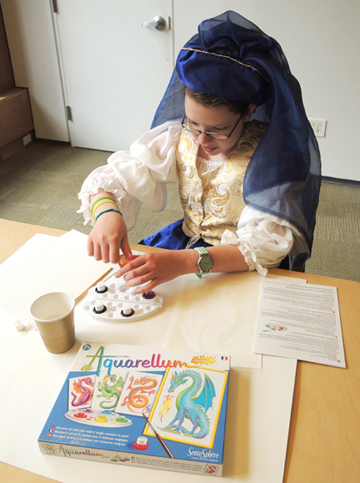 I used the plastic dropper to place the paint in the cavities of the palette, tested the mixed colors on a piece of paper, and washed the dropper and the brush off in a cup of water.
I used the plastic dropper to place the paint in the cavities of the palette, tested the mixed colors on a piece of paper, and washed the dropper and the brush off in a cup of water.
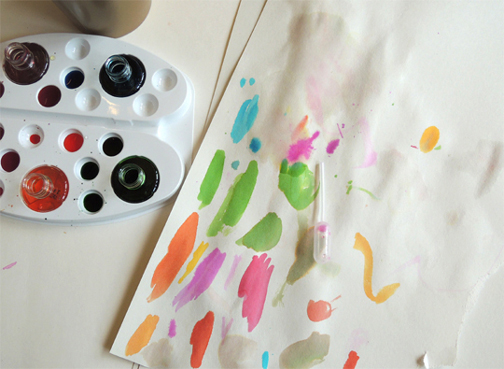 Then I started to paint. Oh! What fun!!! The colors were vibrant, the paint easy to use, and it was nearly impossible to mess up!
Then I started to paint. Oh! What fun!!! The colors were vibrant, the paint easy to use, and it was nearly impossible to mess up!
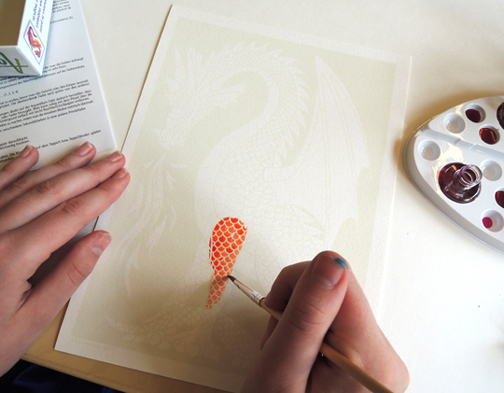 I finished one dragon, and moved onto the next. I found that the paint dried super quick, which made it easy to layer more colors onto the canvas, creating new shades. It was awesome! The only downside was that the paint dried so quickly, it sometimes dried on the wax, creating smudges. Here’s a finished canvas:
I finished one dragon, and moved onto the next. I found that the paint dried super quick, which made it easy to layer more colors onto the canvas, creating new shades. It was awesome! The only downside was that the paint dried so quickly, it sometimes dried on the wax, creating smudges. Here’s a finished canvas:
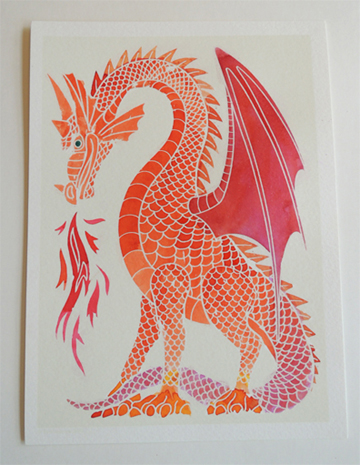 Overall, I really enjoyed this project! It was super fun, and my results turned out beautifully, even though I am not an expert at painting. The only downsides of the product were that if you went outside the main outline of the dragon, the smudges dried so fast that they could permanently mar your art.
Overall, I really enjoyed this project! It was super fun, and my results turned out beautifully, even though I am not an expert at painting. The only downsides of the product were that if you went outside the main outline of the dragon, the smudges dried so fast that they could permanently mar your art.
Also, the bulk of the instructions were in French! This was especially frustrating because the French instructions were beautifully illustrated and clearly had more detail than the paragraph written in English. Also, Dr. Dana and I could not figure out the correct way to pronounce the product name! Aquarellum? What a tongue twister!
And the Scores Are In!
AQUARELLUM
PROS: Fun to use, vibrant colors, easy, entertaining, beautiful results.
CONS: Directions mostly in French, smudges dried too quickly.
SCORE: 5 OUT OF 5!!!!!!!!!!!!!!!!!!!!!!!!!!!!!
Setting aside the dragons, I turned to the weaponry….BEHOLD! A catapult!
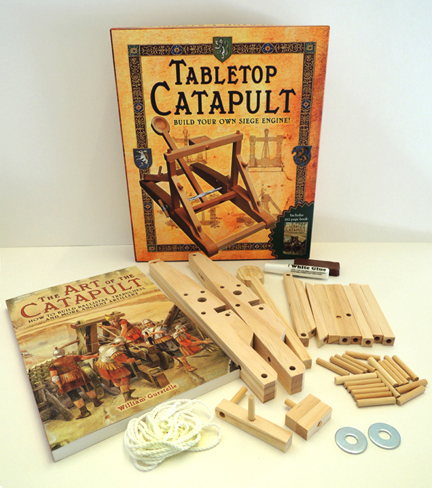 Opening the box, I found a book titled The Art of the Catapult, wood pieces, wooden pegs, directions, a chunk of brown clay in a plastic baggie, metal washers, white twine, a wire, and some glue. Unfolding the directions, I discovered that they were mostly illustrated. While I liked that they were so precisely illustrated, the text directions were vague, which confused me. The directions also called for a “Healthy Snack,” which was funny, because we only had marshmallows handy (more on those later)!
Opening the box, I found a book titled The Art of the Catapult, wood pieces, wooden pegs, directions, a chunk of brown clay in a plastic baggie, metal washers, white twine, a wire, and some glue. Unfolding the directions, I discovered that they were mostly illustrated. While I liked that they were so precisely illustrated, the text directions were vague, which confused me. The directions also called for a “Healthy Snack,” which was funny, because we only had marshmallows handy (more on those later)!
I used the inventory sheet on the first page to make sure I wasn’t missing any pieces, and started building the catapult. It was pretty straightforward. Use the wooden pegs to connect the wood pieces together to construct the base of the catapult.
 However, some of the pegs were loose. I used some glue, which (thankfully) seemed to help. Other pegs were too tight and had to be hammered in with a piece of stone that Dr. Dana had in her office!?! It was ludicrous, but equally hilarious, to see me pounding pegs into the wood with a huge chunk of stone. Rock dust flew everywhere, and the noise… let’s just say it was painful.
However, some of the pegs were loose. I used some glue, which (thankfully) seemed to help. Other pegs were too tight and had to be hammered in with a piece of stone that Dr. Dana had in her office!?! It was ludicrous, but equally hilarious, to see me pounding pegs into the wood with a huge chunk of stone. Rock dust flew everywhere, and the noise… let’s just say it was painful.
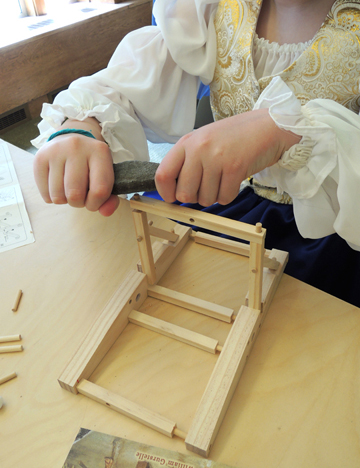 After I had finished building the base and support structure, I had to construct the torsion string. When I saw the word torsion I thought, “WHAAAAAAAAT?!?!” (Torsion means “to be twisted” or “the act of being twisted”).
After I had finished building the base and support structure, I had to construct the torsion string. When I saw the word torsion I thought, “WHAAAAAAAAT?!?!” (Torsion means “to be twisted” or “the act of being twisted”).
In a nutshell, to make the torsion string, I had to coil the string several times and use a wire to thread it through two washers and two holes in the catapult base. Then I wound the ends of the string loops around two pegs (called the “tensioners”). The catapult’s swing arm was inserted in the center of the torsion string and I used the tensioners to tighten it. Dr.Dana assisted, using her knightly muscle.
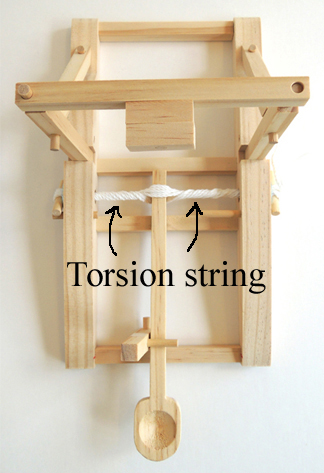 The directions for this part definitely could’ve used more clarification. The picture/word combination was just too weak for the complexity of the task. I couldn’t figure it out, so I called in Dr. Dana, who also had to carefully inspect the directions and fiddle with the catapult. But figure it out we did!
The directions for this part definitely could’ve used more clarification. The picture/word combination was just too weak for the complexity of the task. I couldn’t figure it out, so I called in Dr. Dana, who also had to carefully inspect the directions and fiddle with the catapult. But figure it out we did!
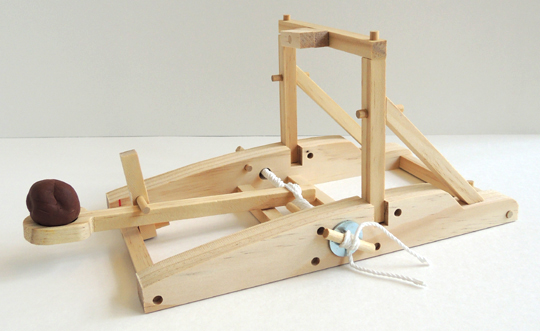 We made a ball out of the clay…but there was another problem. The wooden peg on the “trigger” was too weak to hold the catapult arm back – the peg just kept popping out. So Dr. Dana reinforced it somewhat with masking tape.
We made a ball out of the clay…but there was another problem. The wooden peg on the “trigger” was too weak to hold the catapult arm back – the peg just kept popping out. So Dr. Dana reinforced it somewhat with masking tape.
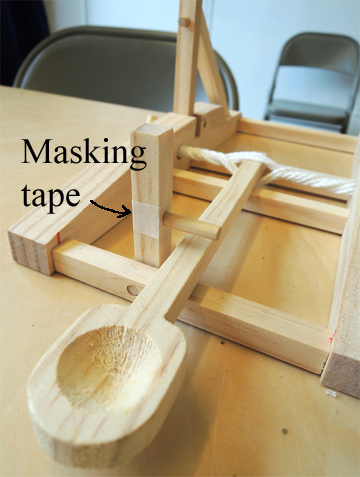 But there was another problem. Now the entire trigger would flop over, releasing the catapult arm. It just wasn’t strong enough to hold the arm down. So we ignored the trigger and used our fingers to hold down catapult arm while we loaded it.
But there was another problem. Now the entire trigger would flop over, releasing the catapult arm. It just wasn’t strong enough to hold the arm down. So we ignored the trigger and used our fingers to hold down catapult arm while we loaded it.
But it was fun to use! It was just so utterly entertaining to watch stuff fly through the air! First, we launched the clay ball. Later, we launched a marshmallow and a ping pong ball. The clay ball had the lowest altitude when launched, the marshmallow went the farthest distance, and the ping pong ball went the highest.
Then we decided (of course) to try to launch a marshmallow into curatorial staffer Ellen’s mouth. First, we made sure she was wearing proper head and eye gear:
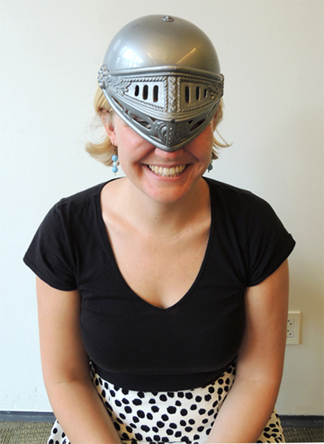 Ellen sat in a chair approximately 65” away from the catapult. We tried again and again, moving the chair all over, but missed every time! Finally, Ellen took matters into her own hands:
Ellen sat in a chair approximately 65” away from the catapult. We tried again and again, moving the chair all over, but missed every time! Finally, Ellen took matters into her own hands:
Needless to say, we had fun!
The kit also came with a book called The Art of the Catapult, by William Gurstelle (Sterling Innovation, 2004). The book was broken up into nine chapters. Each chapter contained at least one or two additional catapult-like projects you could build. However, they were far more complex and difficult than the catapult that came with the kit.
The rest of the book was information about the evolution and variation of catapults around the world. To me… well, some of it was cool. Alexander the Great, Saladin, and Richard the Lionheart. But the rest of the projects and history of the catapult…. frankly, it felt like too much dry detail.
In addition, the writing style seemed to change throughout the book. Sometimes it felt like an adventure novel, sometimes a history textbook, and other times, translations of ancient writings, like the Torah, Bible, or Koran. It was odd, because the book was by one author. But maybe the author’s interests were also varied, and his writing simply reflected that. It just didn’t flow very well.
The catapult kit was kind of fun, but overall it was more confusing than excellent. The directions were annoying with their briefly captioned illustrations. The project was recommended for ages 8+. Yet I had to use a rock to hammer pegs into the catapult. To me, it suggests that something is wrong. And so…
The Scores Are In!
TABLETOP CATAPULT
PROS: Fun to use (because of laugh factor. It was so fun to launch marshmallows at Ellen), good excuse to eat marshmallows, sturdy materials, came with a book (yay!), built a catapult!
CONS: Confusing directions with not enough written description, aiming was hard, trigger not effective, clay projectile a bit disappointing, book was a little dry.
SCORE: 3 OUT OF 5!
Postscript: Dr. Dana here! Last night, I took the catapult home to my 2 children (ages 4 and 6). For 3 straight hours, they launched ping pong balls around the house. The little catapult held up beautifully, even though the trigger never worked. We ended up removing the trigger and just using our fingers. For extra fun, use a Sharpie to draw silly faces on the ping pong balls.
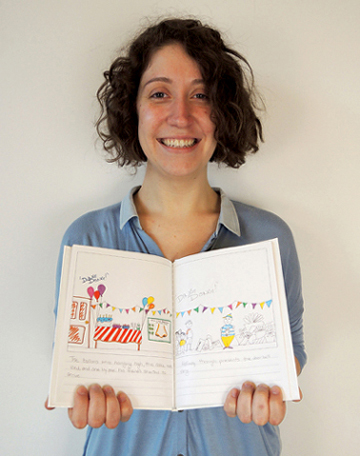 You love books. You think it’s a clever idea. You’ve picked it up while shopping and mused over it a dozen time. But each time you put it back, thinking…do those make your own book mail-in kits really deliver the goods? Well, ponder no more! Today, we’re reviewing the IlluStory Make Your Own Book kit by Lulu Jr.
You love books. You think it’s a clever idea. You’ve picked it up while shopping and mused over it a dozen time. But each time you put it back, thinking…do those make your own book mail-in kits really deliver the goods? Well, ponder no more! Today, we’re reviewing the IlluStory Make Your Own Book kit by Lulu Jr.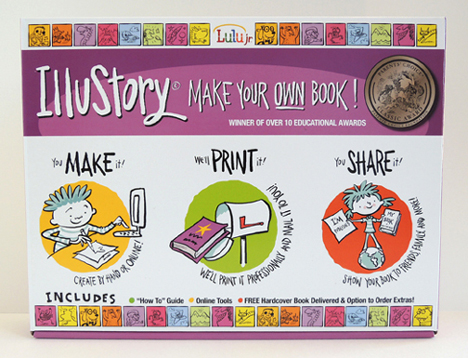 The kit retails for around $20 – $30. It includes 10 washable markers, 20 blank book pages, 2 blank cover pages, a mailing envelope, and detailed instructions. It also has multiple prompt sheets to get young writers going (including – and I really liked this – nonfiction stories and biographies). The kit price includes the production of your book and shipping costs from, and back to, your house (USA only). The final product is a 7.25″ x 9.25″ hardcover book with an illustrated story that is a maximum of 18 pages long.
The kit retails for around $20 – $30. It includes 10 washable markers, 20 blank book pages, 2 blank cover pages, a mailing envelope, and detailed instructions. It also has multiple prompt sheets to get young writers going (including – and I really liked this – nonfiction stories and biographies). The kit price includes the production of your book and shipping costs from, and back to, your house (USA only). The final product is a 7.25″ x 9.25″ hardcover book with an illustrated story that is a maximum of 18 pages long.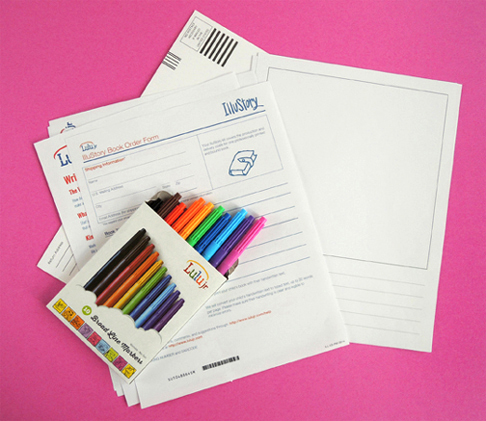 Getting started, you have two creation options with this kit: 1) Draw the book by hand; or 2) Design it online using templates, backgrounds, and digital stickers (you can also upload drawings and photos). We went as low tech as possible and chose to create the book by hand. The 8.5″ x 11″ story pages have a big box for illustrations, and 5 lines for text. Since your story can’t be over 18 pages, there are a couple of extra pages, just in case you mess up.
Getting started, you have two creation options with this kit: 1) Draw the book by hand; or 2) Design it online using templates, backgrounds, and digital stickers (you can also upload drawings and photos). We went as low tech as possible and chose to create the book by hand. The 8.5″ x 11″ story pages have a big box for illustrations, and 5 lines for text. Since your story can’t be over 18 pages, there are a couple of extra pages, just in case you mess up. When the book was finished, we turned to the order form. Here, we were presented with two options: 1) Produce the book using your handwritten text; or 2) Have the company convert your handwritten words to type (but there is a 20 word per page limit, and they don’t correct spelling or edit). We went with hand lettering.
When the book was finished, we turned to the order form. Here, we were presented with two options: 1) Produce the book using your handwritten text; or 2) Have the company convert your handwritten words to type (but there is a 20 word per page limit, and they don’t correct spelling or edit). We went with hand lettering.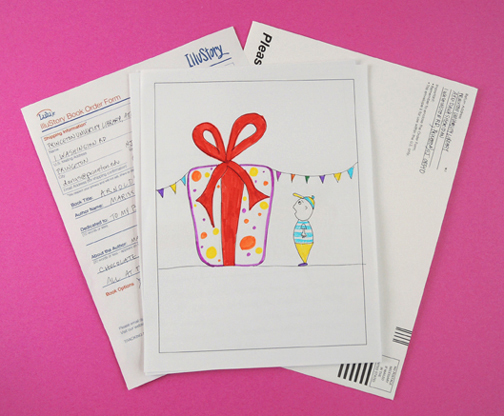 IlluStory say the books are printed less than 2 weeks from the date received, and ship 3-5 days after printing. They were right on the money. In just under 3 weeks, Marissa’s book was back. It looked fantastic.
IlluStory say the books are printed less than 2 weeks from the date received, and ship 3-5 days after printing. They were right on the money. In just under 3 weeks, Marissa’s book was back. It looked fantastic.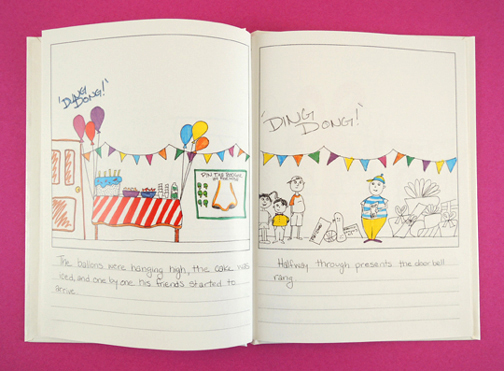 I was worried that the binding might look cheap. Nope. This is a real, honest-to-goodness book. Glossy white cover, crisp printing, text well clear of the binding margins. The author photo we sent was reproduced nicely. They even put the title and author’s name down the book’s spine! There’s a title page too. It looks really cute:
I was worried that the binding might look cheap. Nope. This is a real, honest-to-goodness book. Glossy white cover, crisp printing, text well clear of the binding margins. The author photo we sent was reproduced nicely. They even put the title and author’s name down the book’s spine! There’s a title page too. It looks really cute: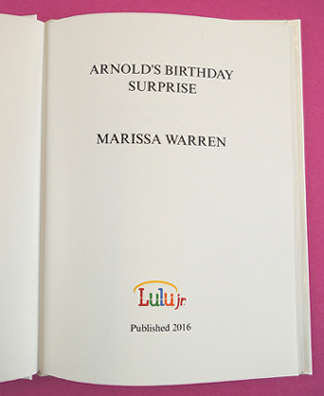 You also have the option to purchase additional copies and send them to your adoring fans (copies of our book, for example are $14.99). You can order multiple copies in advance, or use the info printed on the back of the book to order copies later.
You also have the option to purchase additional copies and send them to your adoring fans (copies of our book, for example are $14.99). You can order multiple copies in advance, or use the info printed on the back of the book to order copies later.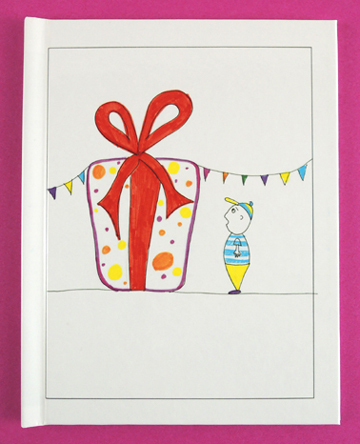 In summary, the IlluStory Make Your Own Book kit is terrific! It’s easy to put together with really nice, professional-looking results. Make sure to read all the instructions and fine print and remember – what you send is exactly what is printed. If you know an aspiring author or illustrator, or are looking to create something special for someone, this kit is a sure bet.
In summary, the IlluStory Make Your Own Book kit is terrific! It’s easy to put together with really nice, professional-looking results. Make sure to read all the instructions and fine print and remember – what you send is exactly what is printed. If you know an aspiring author or illustrator, or are looking to create something special for someone, this kit is a sure bet.
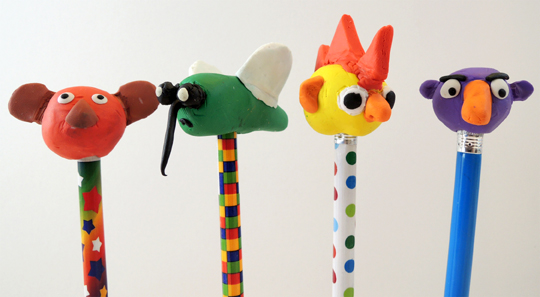 Every writer needs a pencil, and at the end of that pencil is…an eraser. By why settle for the cylindrical pink variety when you can opt for a colorful, unique creation of your own imagination? Enter the Creatibles D.I.Y. Eraser Kit, which retails for around $12. The kit includes a rainbow assortment of clay colors that you can sculpt and bake into custom erasers.
Every writer needs a pencil, and at the end of that pencil is…an eraser. By why settle for the cylindrical pink variety when you can opt for a colorful, unique creation of your own imagination? Enter the Creatibles D.I.Y. Eraser Kit, which retails for around $12. The kit includes a rainbow assortment of clay colors that you can sculpt and bake into custom erasers. Our kid tester, Hope, is taking a break to tackle middle school madness (classes, school play, going to regionals for the National History Day competition…go Hope!), so Marissa took the Creatibles Kit for a test drive. Take it away, Marissa!
Our kid tester, Hope, is taking a break to tackle middle school madness (classes, school play, going to regionals for the National History Day competition…go Hope!), so Marissa took the Creatibles Kit for a test drive. Take it away, Marissa!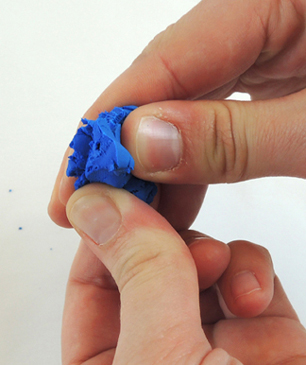 When working on my first eraser, I was conservative in my design and how much clay I used. I didn’t think there would be enough (each color is only 0.63 ounces). But I soon realized that I didn’t need that much (unless you’re making a gigantic multi-color dinosaur). The more comfortable I became with the clay, the more I experimented with detail and size.
When working on my first eraser, I was conservative in my design and how much clay I used. I didn’t think there would be enough (each color is only 0.63 ounces). But I soon realized that I didn’t need that much (unless you’re making a gigantic multi-color dinosaur). The more comfortable I became with the clay, the more I experimented with detail and size.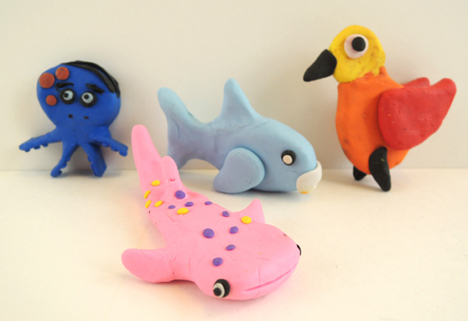 Some of the colors (like black, green, and blue) will rub off on your hands and table. So it’s a good idea to wash your hands in between colors. Also, use parchment paper. It really helps keep clay residue off your work table.
Some of the colors (like black, green, and blue) will rub off on your hands and table. So it’s a good idea to wash your hands in between colors. Also, use parchment paper. It really helps keep clay residue off your work table. When adding little detailed pieces to your erasers, make sure you stick the pieces on well! I had a few eyes and limbs fall off because I didn’t press them down hard enough. Eventually, I used a plastic knife for pressing. Clay modeling tools would probably help and look cleaner, but you don’t have to get that fancy – a plastic knife works fine!
When adding little detailed pieces to your erasers, make sure you stick the pieces on well! I had a few eyes and limbs fall off because I didn’t press them down hard enough. Eventually, I used a plastic knife for pressing. Clay modeling tools would probably help and look cleaner, but you don’t have to get that fancy – a plastic knife works fine!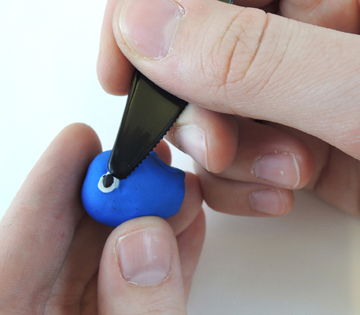
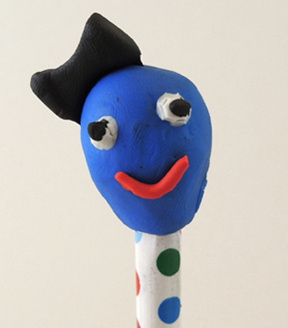 The erasers need to bake at 210-250 degrees for 30 minutes (I went with 250 degrees) then cool and set for 1 hour. I used parchment paper to protect my cookie sheet as well. The hardest part of this project? Waiting the full hour while the erasers cooled down and hardened! I kept checking them every 15 minutes (and if you poke them and they haven’t set, you run the risk of leaving a fingerprint or losing small pieces).
The erasers need to bake at 210-250 degrees for 30 minutes (I went with 250 degrees) then cool and set for 1 hour. I used parchment paper to protect my cookie sheet as well. The hardest part of this project? Waiting the full hour while the erasers cooled down and hardened! I kept checking them every 15 minutes (and if you poke them and they haven’t set, you run the risk of leaving a fingerprint or losing small pieces).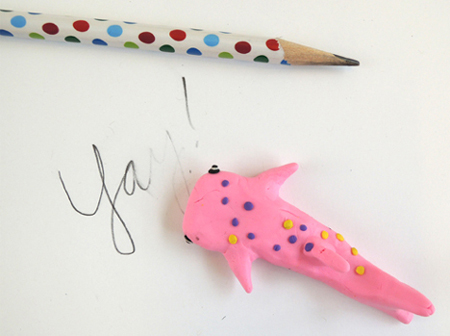 And they work! The pencil residue will stick to the erasers, so if you’re truly using them to erase, they won’t stay pretty for long (or rub the eraser on blank paper to clean it). The eraser doesn’t break or wear down quickly either. Even after some rigorous erasing, the pink shark’s chin was still intact!
And they work! The pencil residue will stick to the erasers, so if you’re truly using them to erase, they won’t stay pretty for long (or rub the eraser on blank paper to clean it). The eraser doesn’t break or wear down quickly either. Even after some rigorous erasing, the pink shark’s chin was still intact!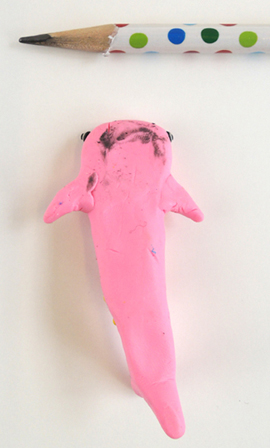 There’s no stated age range for this kit, but I think it would be good for ages 6 & up. However, because the clay starts out dry and crumbly, younger kids might have a difficult time handling it on their own. But once the clay gets to Play-Doh consistency, it’s fine. Also (and it says this on the kit) the clay could stain “certain finishes” and should be kept away from “carpet, clothing, and other porous surfaces.”
There’s no stated age range for this kit, but I think it would be good for ages 6 & up. However, because the clay starts out dry and crumbly, younger kids might have a difficult time handling it on their own. But once the clay gets to Play-Doh consistency, it’s fine. Also (and it says this on the kit) the clay could stain “certain finishes” and should be kept away from “carpet, clothing, and other porous surfaces.”












